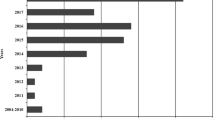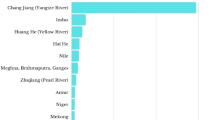Abstract
Pollen analysis of lake sediments is a time-consuming technique. The laborious sample preparation hampers quick determination of the pollen content and localization of sediment intervals based on palynological criteria within long sediment cores. This study introduces a quick and almost non-destructive pollen analytical method using smear-slides that allows the preliminary determination of the pollen content of lake sediments. Pollen grains are stained with Calberla’s solution. To test the reliability of the method, the results of the smear-slide technique were compared to those of a standard pollen analysis from the same stratigraphic sequence. The data from both techniques produced largely consistent results. Differences between both data sets reflect the statistical uncertainties associated with the low pollen concentrations in the smear slides and the low pollen counts employed in this technique. Despite these limitations, application of this method during the initial investigation of lake sediments can overcome some of the major challenges of paleoenvironmental research projects. The method can be used to rapidly determine important changes in the pollen stratigraphy, which allows the identification of sediment intervals for further, more detailed proxy analysis and the correlation of sediment cores. Knowledge of the pollen stratigraphy at an early stage of a research project can also assist in the selection of samples for radiocarbon dating. In addition, staining of sediment samples in the field can be used to verify the success of lake coring campaigns by comparing preliminarily determined pollen contents with expected pollen assemblages.






Similar content being viewed by others
References
Balsam WL, McCoy FW Jr (1987) Atlantic sediments: glacial/interglacial comparisons. Paleoceanography 2:531–542
Bennett KD (1996) Determination of the number of zones in a biostratigraphical sequence. New Phytol 132:155–170
Bennett KD, Willis KJ (2001) 2. Pollen. In: Smol JP, Birks HJB, Last WM (eds) Tracking environmental change using lake sediments. Volume 3: terrestrial, algal, and siliceous indicators. Kluwer Academic Publishers, Dordrecht, pp 5–32
Beug H-J (2004) Leitfaden der Pollenbestimmung für Mitteleuropa und angrenzende Gebiete. Dr Friedrich Pfeil, München
Birks HJB (1986) Numerical zonation, comparison and correlation of Quaternary pollen-stratigraphical data. In: Berglund BE (ed) Handbook of Holocene palaeoecology and palaeohydrology. Blackburn Press, Caldwell, pp 743–774
Birks HJB (2012) Chapter 2: Overview of numerical methods in palaeolimnology. In: Birks HJB, Lotter AF, Juggins S, Smol JP (eds) Tracking environmental change using lake sediments: data handling and numerical techniques. Springer, Dordrecht, pp 19–92
Blackman VH (1898) On the cytological features of fertilization and related phenomena in Pinus silvestris L. Philos Trans R Soc Lond Ser B 190:395–426
Brookes RHW, Thomas KW (1967) The distribution of pollen grains on microscope slides. I. The non-randomness of the distribution. Pollen Spores 9:621–629
Calberla E (1878) Der Befruchtungsvorgang beim Ei von Petromyzon Planery. Z Wiss Zool 30:437–479
Clarke KR (1993) Non-parametric multivariate analyses of changes in community structure. Aust J Ecol 18:117–143
Faegri K, Kaland PE, Krzywinski K (1989) Textbook of pollen analysis, 4th edn. Wiley, New York
Fischer HCA (1890) Beiträge zur vergleichenden Morphologie der Pollenkörner. J.U. Kern’s, Breslau
Fraser WT, Sephton MA, Watson JS, Self S, Lomax BH, James DI, Wellman CH, Callaghan TV, Beerling DJ (2011) UV-B absorbing pigments in spores: biochemical responses to shade in a high-latitude birch forest and implications for sporopollenin-based proxies of past environmental change. Polar Res 30:8312. doi:10.3402/polar.v30i0.8312
Fraser WT, Scott AC, Forbes AES, Glasspool IJ, Plotnick RE, Kenig F, Lomax BH (2012) Evolutionary stasis of sporopollenin biochemistry revealed by unaltered Pennsylvanian spores. New Phytol 196:397–401
Gay LN, Curtis H, Norris T (1941) A pollen survey of the islands of Bermuda. Bull Johns Hopkins Hosp 68:179–189
Grimm EC (1987) CONISS: a FORTRAN 77 program for stratigraphically constrained cluster analysis by the method of incremental sum of squares. Comput Geosci 13:13–35
Grimm EC (1991) Tilia v. 2.0.b.4. Illinois State Museum, Research and Collections Center, Springfield
Grimm EC (2004) TGView v. 2.0.2, Software. Illinois State Museum, Research and Collections Center, Springfield
Hammer Ø, Harper DAT, Ryan PD (2001) PAST: paleontological statistics software package for education and data analysis. Palaeontol Electron 4:1–9
Horobin RW, Kiernan JA (2002) Conn’s biological stains. BIOS, Oxford
Jones GD (2012) Pollen extraction from insects. Palynology 36:86–109
Kelts KR (2003) Components in lake sediments: smear slide identifications. In: Valero-Garcés BL (ed) Limnogeology in Spain: a tribute to Kerry R. Kelts. Consejo Superior de Investigaciones Científicas, Madrid, pp 59–72
Moore PD, Webb JA, Collinson ME (1991) Pollen analysis. Blackwell, Oxford
Myrbo A, Morrisson A, McEwan A (2011) Smear slides made easier by a new online resource: TMI (Tool for Microscopic Identification). Geol Soc Am Abstr Programs 43(5):466
Niklaus TR, Bonani G, Suter M, Wölfli W (1994) Systematic investigation of uncertainties in radiocarbon dating due to fluctuations in the calibration curve. Nucl Instrum Methods Phys Res B 92:194–200
O’Connell M, Ghilardi B, Morrison L (2014) A 7000-year record of environmental change, including early farming impact, based on lake-sediment geochemistry and pollen data from County Sligo, western Ireland. Quat Res 81:35–49
Ogden EC, Raynor GS, Hayes JV, Lewis DM, Haines JH (1974) Manual for sampling pollen. Hafner Press, New York
Parker AG, Goudi AS, Anderson DE, Robinson MA, Bonsall C (2002) A review of the mid-Holocene elm decline in the British Isles. Phys Geogr 26:1–45
Pratt HN, Colmes A, Fromer J, Greene JE, Chafee FH, Clapp WB (1941) Pollen and mold survey of southeastern New England—1940. New Engl J Med 225:533–538
Reitsma T (1969) Size modification of recent pollen grains under different treatments. Rev Palaeobot Palynol 9:175–202
Rothwell RG (1989) The smear slide method. In: Rothwell RG (ed) Minerals and mineraloids in marine sediments. Springer, Netherlands, pp 21–24
Rull V (1987) A note on pollen counting in palaeoecology. Pollen Spores 29:471–480
Sack S (1949) How far can wind-borne pollen be disseminated? J Allergy 20:453–460
Schnurrenberger D, Russell J, Kelts K (2003) Classification of lacustrine sediments based on sedimentary components. J Paleolimnol 29:141–154
Smith EG (1990) Sampling and identifying allergenic pollens and molds. Blewstone Press, San Antonio
Stolze S, Dörfler W, Monecke T, Nelle O (2012) Evidence for climatic variability and its impact on human development during the Neolithic from Loughmeenaghan, County Sligo, Ireland. J Quat Sci 27:393–403
Stolze S, Muscheler R, Dörfler W, Nelle O (2013) Solar influence on climate variability and human development during the Neolithic: evidence from a high-resolution multi-proxy record from Templevanny Lough, County Sligo, Ireland. Quat Sci Rev 67:138–159
Telford RF, Heegaard E, Birks HJB (2004) The intercept is a poor estimate of a calibrated radiocarbon age. Holocene 14:296–298
Watson JS, Sephton MA, Sephton SV, Self S, Fraser WT, Lomax BH, Gilmour I, Wellman CH, Beerling DJ (2007) Rapid determination of spore chemistry using thermochemolysis gas chromatography-mass spectrometry and micro-Fourier transform infrared spectroscopy. Photochem Photobiol Sci 6:689–694
Wohlfahrt B, Skog G, Possnert G, Holmquist B (1998) Pitfalls in the AMS radiocarbon-dating of terrestrial macrofossils. J Quat Sci 13:137–145
Acknowledgments
I express my gratitude to F. Coates for introducing me to aerobiological research. I am indebted to W. Dörfler, I. Feeser, B. Ghilardi, P. Majkut, O. Nelle, M. O’Connell, and P. O’Rafferty for help provided during the coring campaign. T. Meuzelaar, J. Monecke, and T. Monecke are thanked for helpful discussions. H. Nichols, G. Chen, and two anonymous reviewers provided valuable comments on an earlier version of the manuscript. The field work was made possible through a research grant by the German Research Foundation.
Author information
Authors and Affiliations
Corresponding author
Rights and permissions
About this article
Cite this article
Stolze, S. Rapid determination of the pollen content in lake sediment cores as a tool in paleoenvironmental research. J Paleolimnol 54, 161–170 (2015). https://doi.org/10.1007/s10933-015-9836-4
Received:
Accepted:
Published:
Issue Date:
DOI: https://doi.org/10.1007/s10933-015-9836-4




